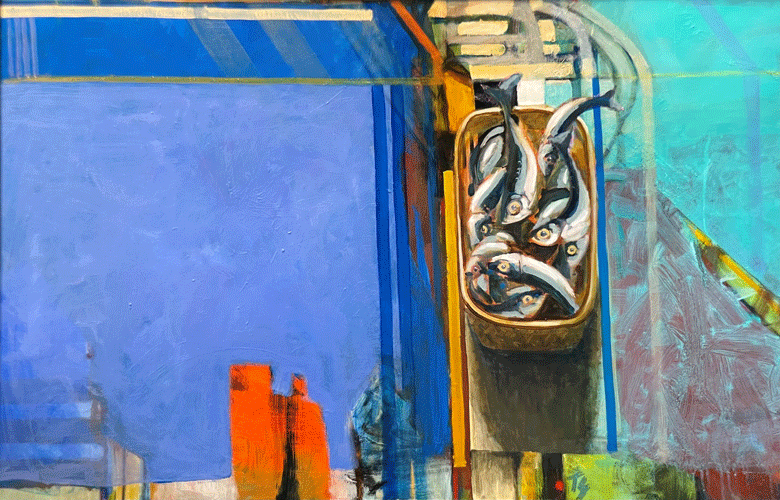The paintings on Tom Glover’s website are divided into eight categories. Some are broad, like “Seascapes” and “Abstracts,” others very specific: “Italy” and “Fenway” (he’s a big-time Red Sox fan).
And then there is “Docks.” There you’ll find semi-abstract images of wharves bedecked with ropes, lobster traps, buoys—even personal flotation devices. And fish: mackerel and the like appear from time to time representing the bounty of the sea.
A mess of fish is featured in “Edge of Blue Sea,” their twisting bodies filling a basket. The painting, Glover notes, was originally going to be a “totem” of gear he saw on a wharf in Portland, but he kept removing the shackles, lines, and floats until the canvas became “a blue plane with only tiny remnants of the gear and pier.”
On occasion, Glover will turn to the fluorescent paint lobstermen use on their buoys…
“Edge of Blue Sea” highlights Glover’s penchant for melding abstract and realistic imagery. He worked from a couple of “stock” photos taken over the years, picking out the elements to create a composite waterfront image alive in line, color, shape, and shadow.
Glover traces this “combinatory method” to his mentor, the celebrated painter John Laurent (1921-2005). Laurent, who nurtured generations of painters during his 30-year tenure at the University of New Hampshire, compared working realistically to a golf game, working abstractly to tennis—“golf being more plodding and predictable,” Glover notes, “tennis, reactionary and unpredictable.”
On occasion, Glover will turn to the fluorescent paint lobstermen use on their buoys as part of his mission to capture “the ruggedness and rawness of the ocean edge and the grind of fishing the sea.” Laurent warned him not to overdo the buoy paint, feeling it might come off as gimmicky, so Glover employs it “very judiciously.”
Laurent remained a mentor after Glover graduated from UNH.
“I continued to bring work to him for critiques and we became friends,” he writes. The older painter took him on what turned out to be his last trip to his fishing camp on Lake Kennebago and showed him “the secret fishing pools and told stories about fish he had caught.” Laurent was too unsteady to climb into the canoe, Glover recalls, “but insisted that I go out early in the morning to experience the lake.”
Laurent shared stories of his life in art, including studying with his father, famed French-born sculptor Robert Laurent (1890-1970), who co-founded the Ogunquit Summer School of Graphic Arts with his mentor, Hamilton Easter Field. He also encouraged Glover to start looking at great art, which led him to Europe and elsewhere to study old and modern masters. After Laurent died, his sons gave Glover their father’s easel, which he uses to this day.
Born in Keene, N.H., Glover graduated from UNH with a BFA degree in 1984, after which he moved to Hasbrouck Heights, N.J. He worked briefly at the Metropolitan Museum of Art before taking a job as a picture framer. A year or so later he returned to New Hampshire and worked at Great Bay Marine in Newington, N.H., starting in the yard painting and repairing boats, then moving into the chandlery. He handled boat and outboard motor sales before becoming the purchasing agent for the marina.
For several years Glover lectured at the University of Connecticut to science education graduate students on “The Landscape, Mythology, and the Artist.” He also taught painting at the UNH Department of Continuing Education and now teaches at Sanctuary Arts in Eliot.
A resident of Rollinsford, N.H., Glover maintained a studio in the Rollinsford Mills building for 21 years. Today, he has a new home studio where he works “almost every day.”
And he is lover of islands, be it Great Spruce Head, Block Island, Deer Isle, or the Isles of Shoals where he has taught workshops. Over the years Glover has painted a number of working waterfronts: Portland, Kittery, and Portsmouth.
His favorite working wharf, he states, is “the next one that excites me.” He visits as many marinas and fishing docks as he can, “anywhere there might be activity with boats, fishing gear, mooring balls, etc.” He loves the edge of the ocean “where we embark to venture out on the sea.”
Glover shows at a number of Maine and New Hampshire galleries. For a full list, visit www.tpgloverart.com. Several of his Fenway paintings appear in “In the Moment,” an exhibition of sports-related art curated by Wes LaFountain and Bob Keyes at Cove Street Arts in Portland (through Dec. 2).
Carl Little lives and writes on Mount Desert Island.





